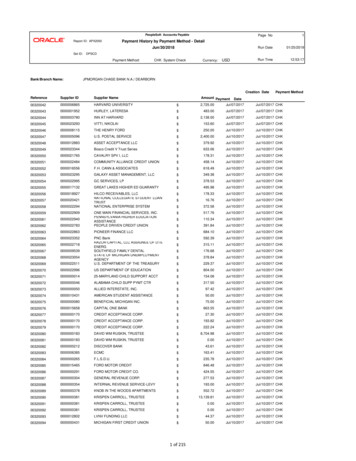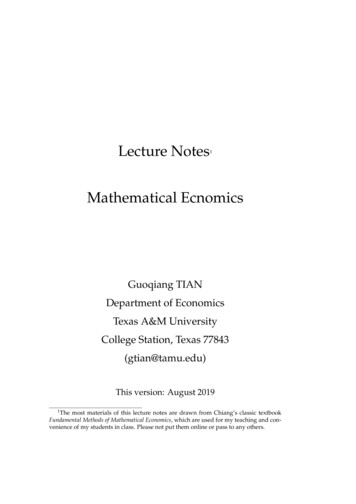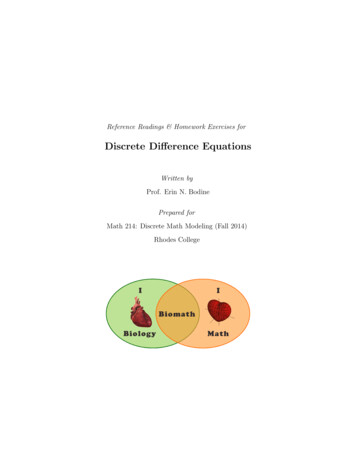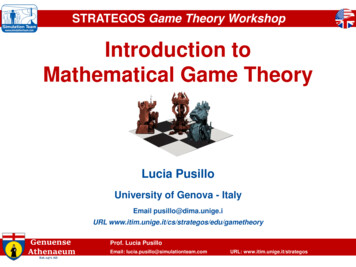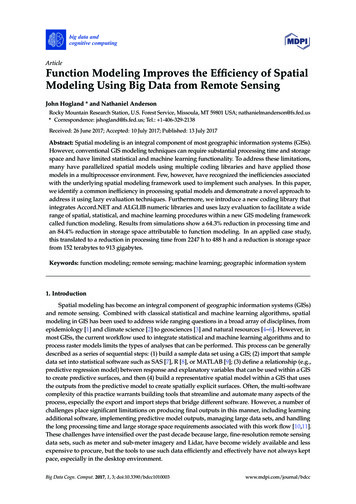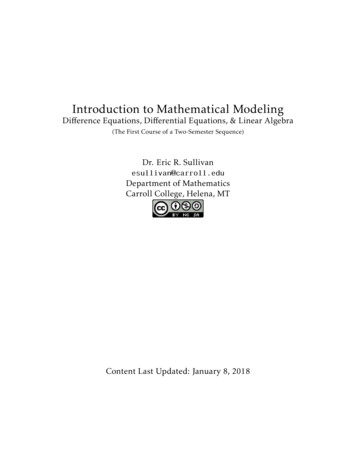
Transcription
Introduction to Mathematical ModelingDifference Equations, Differential Equations, & Linear Algebra(The First Course of a Two-Semester Sequence)Dr. Eric R. Sullivanesullivan@carroll.eduDepartment of MathematicsCarroll College, Helena, MTContent Last Updated: January 8, 2018
1 Eric Sullivan. Some Rights Reserved.This work is licensed under a Creative Commons Attribution-NonCommercial-ShareAlike4.0 International License. You may copy, distribute, display, remix, rework, and perform this copyrighted work, but only if you give credit to Eric Sullivan, and all derivative works based upon it must be published under the Creative Commons AttributionNonCommercial-Share Alike 4.0 United States License. Please attribute this work to EricSullivan, Mathematics Faculty at Carroll College, esullivan@carroll.edu. To view a copyof this license, /4.0/or send a letter to Creative Commons, 171 Second Street, Suite 300, San Francisco, California, 94105, USA.
Contents0 To the Student and the Instructor0.1 An Inquiry Based Approach . . . . . . . . . . . . . . . . . . . . . . . . . . .0.2 Online Texts and Other Resources . . . . . . . . . . . . . . . . . . . . . . . .0.3 To the Instructor . . . . . . . . . . . . . . . . . . . . . . . . . . . . . . . . . .55771 Fundamental Notions from Calculus1.1 Sections from Active Calculus . . . . . . . . . . . . . . . . . . . . . . . . . .1.2 Modeling Explorations with Calculus . . . . . . . . . . . . . . . . . . . . . .99102 An Introduction to Linear Algebra2.1 Why Linear Algebra? . . . . . . . . . . . . . . . . . . . .2.2 Matrix Operations and Gaussian Elimination . . . . . .2.3 Gaussian Elimination: A First Look At Solving Systems2.4 Systems of Linear Equations . . . . . . . . . . . . . . . .2.5 Linear Combinations . . . . . . . . . . . . . . . . . . . .2.6 Inverses and Determinants . . . . . . . . . . . . . . . . .2.6.1 Inverses . . . . . . . . . . . . . . . . . . . . . . . .2.6.2 Determinants . . . . . . . . . . . . . . . . . . . .2.7 Technology For Linear Algebra . . . . . . . . . . . . . . .2.8 The Magic Carpet Ride . . . . . . . . . . . . . . . . . . .2.9 Span . . . . . . . . . . . . . . . . . . . . . . . . . . . . . .2.10 Linear Independence, Linear Dependence, and Basis . .2.11 The Column and Null Spaces of a Matrix . . . . . . . . .2.12 Modeling Explorations with Linear Algebra . . . . . . .2.12.1 Input-Output Economies . . . . . . . . . . . . . .2.12.2 Traffic Networks . . . . . . . . . . . . . . . . . . .2.12.3 Balancing Chemical Equations . . . . . . . . . .1616202328353840424749515459616264663 First Order Models3.1 Birth, Death, and Immigration Exploration . . . . . . . . . . . .3.2 Models for Birth, Death, and Immigration . . . . . . . . . . . .3.3 Difference Equations and Differential Equations . . . . . . . . .3.4 Stability and Equilibria . . . . . . . . . . . . . . . . . . . . . . .3.5 Euler’s Method: Numerical Solutions for Differential Equations3.6 Classifying Difference and Differential Equations . . . . . . . .686870737981862.
CONTENTS33.7 Technique: Solving 1st Order Linear Homogeneous Equations . . .3.8 Technique: Solving 1st Order Linear Nonhomogeneous Equations3.8.1 Solution Technique: Separation of Variables . . . . . . . . .3.8.2 Solution Technique: Undetermined Coefficients . . . . . . .3.9 Modeling Explorations with Difference and Differential Equations4 Second Order Models4.1 Modeling Oscillations . . . . . . . . . . . . . . . . . . . . . . .4.2 Homogeneous Linear 2nd Order Differential Equations . . . .4.3 Forced Oscillations . . . . . . . . . . . . . . . . . . . . . . . .4.4 Energy in Mass Spring Systems – A Lab Exploration . . . . .4.5 Modeling Explorations with 2nd Order Differential Equations. 88. 90. 90. 95. 102.1131131161231251295 Systems of Difference and Differential Equations5.1 Spread of Disease . . . . . . . . . . . . . . . . . . . . . . . . . . . .5.2 Spreading a Juicy Rumor . . . . . . . . . . . . . . . . . . . . . . . .5.3 The H1N1 Virus . . . . . . . . . . . . . . . . . . . . . . . . . . . . .5.4 Writing Systems of Difference Equations . . . . . . . . . . . . . . .5.5 Linear Systems . . . . . . . . . . . . . . . . . . . . . . . . . . . . . .5.6 The Eigenvalue / Eigenvector Problem . . . . . . . . . . . . . . . .5.6.1 Geometry of Eigenvectors and Eigenvalues . . . . . . . . .5.6.2 The Eigenvalue Eigenvector Problem . . . . . . . . . . . . .5.6.3 Technology for the Eigenvalue Eigenvector Problem . . . .5.7 Markov Chains . . . . . . . . . . . . . . . . . . . . . . . . . . . . . .5.8 Analysis of Linear Systems . . . . . . . . . . . . . . . . . . . . . . .5.8.1 Homogeneous Systems of Linear Difference Equations . . .5.8.2 Analysis of Equilibrium Behavior . . . . . . . . . . . . . . .5.8.3 Non Homogeneous Systems of Linear Difference Equations5.9 Modeling Explorations with Systems . . . . . . . . . . . . . . . . 6 Infinite Series1746.1 Sections from Active Calculus . . . . . . . . . . . . . . . . . . . . . . . . . . 174Appendices175A MATLAB BasicsA.1 Vectors and Matrices . . . . . .A.2 Looping . . . . . . . . . . . . . .A.2.1 For Loops . . . . . . . .A.2.2 The While Loop . . . . .A.3 Conditional Statements . . . . .A.3.1 If Statements . . . . . . .A.3.2 Case-Switch StatementsA.4 Functions . . . . . . . . . . . . .A.5 Plotting . . . . . . . . . . . . . .176176178178179180180181181182.
CONTENTS4A.6 Animations . . . . . . . . . . . . . . . . . . . . . . . . . . . . . . . . . . . . . 183
Chapter 0To the Student and the InstructorThis document contains lecture notes, classroom activities, examples, and challenge problems specifically designed for a first semester of differential equations and linear algebrataught with a focus on mathematical modeling. The content herein is written and maintained by Dr. Eric Sullivan of Carroll College. Problems were either created by Dr. Sullivan, the Carroll Mathematics Department faculty, part of NSF Project Mathquest, partof the Active Calculus text, or come from other sources and are either cited directly orcited in the LATEX source code for the document (and are hence purposefully invisible tothe student).0.1An Inquiry Based ApproachProblem 0.1 (Setting The Stage). Get in groups of size 3-4. Group members should introduce themselves. For each of the questions that follow I will ask you to:1. Think about a possible answer on your own2. Discuss your answers with the rest of the group3. Share a summary of each group’s discussionQuestions:Question #1: What are the goals of a university education?Question #2: How does a person learn something new?Question #3: What do you reasonably expect to remember from your courses in 20 years?Question #4: What is the value of making mistakes in the learning process?Question #5: How do we create a safe environment where risk taking is encouraged andproductive failure is valued?N5
CHAPTER 0. TO THE STUDENT AND THE INSTRUCTOR6(The previous problem is inspired by Dana Ernst’s first day activity in IBL activitytitled: Setting the Stage.)“Any creative endeavor is built in the ash heap of failure.”–Michael StarbirdThis material is written with an Inquiry-Based Learning (IBL) flavor. In that sense, thisdocument could be used as a stand-alone set of materials for the course but these notesare not a traditional textbook containing all of the expected theorems, proofs, examples,and exposition. The students are encouraged to work through problems and homework,present their findings, and work together when appropriate. You will find that this document contains collections of problems with only minimal interweaving exposition. It isexpected that you do every one of the problems and then use other more traditional textsas a backup when you are stuck. Let me say that again: this is not the only set of materialfor the course. Your brain, your peers, and the books linked in the next section are yourbest resources when you are stuck.To learn more about IBL go to http://www.inquirybasedlearning.org/about/. Thelong and short of it is that the students in the class are the ones that are doing the work;building models, proving theorems, writing code, working problems, leading discussions, and pushing the pace. The instructor acts as a guide who only steps in to redirectconversations or to provide necessary insight. If you are a student using this material youhave the following jobs:1. Fight! You will have to fight hard to work through this material. The fight is exactlywhat we’re after since it is ultimately what leads to innovative thinking.2. Screw Up! More accurately, don’t be afraid to screw up. You should write code,work problems, and prove theorems then be completely unafraid to scrap whatyou’ve done and redo it from scratch. Learning this material is most definitely anon-linear path.* Embrace this!3. Collaborate! You should collaborate with your peers with the following caveats: (a)When you are done collaborating you should go your separate ways. When youwrite your solution you should have no written (or digital) record of your collaboration. (b) The internet is not a collaborator. Use of the internet to help solve theseproblems robs you of the most important part of this class; the chance for originalthought.4. Enjoy! Part of the fun of IBL is that you get to experience what it is like to think likea true mathematician / scientist. It takes hard work but ultimately this should befun!* Punintended: our goal, after all, is really to understand that linear algebra is the glue that holds mathematics together.
CHAPTER 0. TO THE STUDENT AND THE INSTRUCTOR0.27Online Texts and Other ResourcesIf you are looking for online textbooks for linear algebra and differential equations I canpoint you to a few. Some of the following online resources may be a good place to help youwhen you’re stuck but they will definitely say things a bit differently. Use these resourceswisely. The book Differential Equations with Linear Algebra, An inquiry based approach tolearning is a nice collection of notes covering much of the material that we cover inour class. The order is a bit different but the notes are well -70362f8b9735/1/316-IBL%20(2013Spring).pdf The ODE Project by Thomas Juson is a nice online text that covers many (but notall) of the topics that we cover in differential roject.html Elementary Differential Equations by William Trench. This book contains everything(!) you would ever want to look up for ordinary differential equations. It is agreat resource to look up ODE s/TRENCH DIFF EQNS I.PDF A First Course in Linear Algebra by Robert Beezer. This book is very thorough andcovers everything that we do in linear algebra and much more.linear.ups.edu/fcla/index.html Linear Algebra Workbook by TJ Hitchman. This is a workbook for Dr. Hitchman’sclass at U. Northern Iowa. Even though it is only a “workbook” it contains somenice explanations and it has embedded executable code for some ourse-materials/workbook/LinAlgWorkbook.html0.3To the InstructorIf you are an instructor wishing to use these materials then I only ask that you adhereto the Creative Commons license. You are welcome to use, distribute, and remix thesematerials for your own purposes. Thanks for considering my materials for your course!My typical use of these materials are to let the students tackle problems in smallgroups during class time and to intervene when more explanation appears to be necessaryor if the students appear to be missing the deeper connections behind problems. Thecourse that I have in mind for these materials is a first semester of differential equationsand linear algebra taught from the standpoint of mathematical modeling. As such, this isnot a complete collection of materials for either differential equations or linear algebra inisolation. We discuss matrix operations, Gaussian elimination, the eigenvalue problem,first order linear homogeneous and non-homogeneous differential equations, and secondorder homogeneous differential equations. In the second course we will expand uponthese ideas and include more advanced topics.
CHAPTER 0. TO THE STUDENT AND THE INSTRUCTOR8Many of the theorems in the text come without a proof. If the theorem is followed bythe statement “prove the previous theorem” then I expect the students to have the skill toprove that theorem and to do so with the help of their small group. However, this courseis not intended to be a proof-based mathematics course so several theorems are statedwithout rigorous proof. If you are looking for a proof-based linear algebra or differentialequations course then I believe that these notes will not suffice. I have, however, triedto give thought provoking problems throughout so that the students can engage withthe material at a level higher than just the mechanics of differential equations and linearalgebra. There are also several routine exercises throughout the notes that will allowstudents to practice mechanical skills.There is a toggle switch in the LATEX code that allows you to turn on and off the solutions to problems. The line of code\def\ShowSoln{0}is a switch that, when set to 0, turns the solutions off and when set to 1 turns the solutionson. Just re-compile (pdflatex) the document to display the solutions. I typically do notshow the solutions to the students while they’re learning the material.
Chapter 1Fundamental Notions from CalculusWelcome to the mathematical modeling class. We’ll start the class with a brief review ofthe most basic ideas and notions from calculus. If you have never taken a Calculus coursebefore then you should consider first taking a formal Calculus course before tackling thisclass. We only need a few of the main ideas for this class so what you’ll find in this chapteris necessarily brief.1.1Sections from Active CalculusThe Active Calculus Textbook is a wonderful online resource that stands in place of thischapter. We will only discuss a few select sections and you can find the relevant linksbelow. If you need further reading to brush up on Calculus you should use the ActiveCalculus text.1. Active Calculus Section 1.1: How do we measure velocity?2. Active Calculus Section 1.2: The notion of a limit3. Active Calculus Section 1.4 The Derivative Function4. Active Calculus Section 2.1: Elementary derivative rules5. Active Calculus Section 2.2: The sine and cosine functions6. Active Calculus Section 2.3: The product and quotient rules7. Active Calculus Section 2.4: The chain rule8. Active Calculus Section 4.3: The definite integral9. Active Calculus Section 4.4: The Fundamental Theorem of Calculus9
CHAPTER 1. FUNDAMENTAL NOTIONS FROM CALCULUS1.210Modeling Explorations with CalculusWhat remains in this chapter of these notes are several laboratory exercises meant to support your review of Calculus and to introduce you to the basic notions of mathematicalmodeling.Problem 1.1. Water is being drained from a hole near the bottom of a cylindrical tank.According to Torrecelli’s Law it can be shown that the rate at which the height h of thewater changes is proportional to the square root of the height. This can be written withaverage rates of change as:average rate of change of the height h K· h t(1.1)where K is a constant that depends on gravity as well as the size of the hole and the shapeof the tank.hOutflow(a) Using the video demonstration of Torrecelli’s Law found here:https://www.youtube.com/watch?v gsNdsuQ1ZCo&app desktopand, using the pause button to your advantage, create a table of time vs. the heightof the water in the container. Use as many data points as you feel necessary.Time (sec).Height (cm).(b) Use your data to estimate the value of K in the experiment shown in the video. Besure to include a discussion of units of K and discuss which parts of this experimentare being described by K? (Hint: Given equation (1.1), what should a plot of h (on the x axis) vs h t (on the yaxis) look like? How would you find K from this plot?)(c) Two more experiments were performed with different cylinders and different sizeddrain holes. Find the values of K for each of these experiments, and from the datamake comparisons between the sizes of the cylinders and the sizes of the holes forthe three experiments.
CHAPTER 1. FUNDAMENTAL NOTIONS FROM CALCULUSExperiment #1Time (sec) Height (cm)0358301625252035.51548.71066.8511Experiment #2Time (sec) Height 7.5548.55310.45213.451(d) Discussion: What would happen if this experiment were run on a different, noncylindrical, tank? Provide a detailed explanation.NProblem 1.2. A farmer with large land holdings has historically grown a wide variety ofcrops. With the price of ethanol fuel rising, he decides that it would be prudent to devotemore and more of his acreage to producing corn. As he grows more and more corn, helearns efficiencies that increase his yield per acre. In the present year, he used 7000 acresof his land to grow corn, and that land had an average yield of 170 bushels per acre. At thecurrent time, he plans to increase his number of acres devoted to growing corn at a rateof 600 acres/year, and he expects that right now his average yield is increasing at a rateof 8 bushels per acre per year. Use this information to answer the following questions.(a) Say that the present year is t 0, that A(t) denotes the number of acres the farmerdevotes to growing corn in year t, Y (t) represents the average yield in year t (measured in bushels per acre), and C(t) is the total number of bushels of corn the farmerproduces. What is the formula for C(t) in terms of A(t) and Y (t)? Why?(a) What is the value of C(0)? What does it measure?(a) Write an expression for C 0 (t) in terms of A(t), A0 (t), Y (t), and Y 0 (t). Explain yourthinking.(a) What is the value of C 0 (0)? What does it measure?(a) Based on the given information and your work above, estimate the value of C(1).(a) Assume that the annual yield decreases every year by 8 bushels per acre. Writeexpressions for C(t) and C 0 (t), find the approximate time and number of bushelswhen the total number of bushels is maximized, and discuss how the maximumvalue would change if the farmer were able to control the rate at which the yielddecreased. Present your solution with thorough discussion and appropriate plots.
CHAPTER 1. FUNDAMENTAL NOTIONS FROM CALCULUS12NProblem 1.3. Let f (v) be the gas consumption (in liters/km) of a car going at velocity v(in km/hour). In other words, f (v) tells you how many liters of gas the car uses to go onekilometer if it is traveling at v kilometers per hour. In addition, suppose that f (80) 0.05and f 0 (80) 0.0004.(a) Let g(v) be the distance the same car goes on one liter of gas at velocity v. What isthe relationship between f (v) and g(v)? Hence find g(80) and g 0 (80).(b) Let h(v) be the gas consumption in liters per hour of a car going at velocity v. Inother words, h(v) tells you how many liters of gas the car uses in one hour if it isgoing at velocity v. What is the algebraic relationship between h(v) and f (v)? Hencefind h(80) and h0 (80).(c) How would you explain the practical meaning of these function and derivative values to a driver who knows no calculus? Include units on each of the function andderivative values you discuss in your response.NProblem 1.4. The velocity (m/s) of an object dropped from a helicopter 1000 meters highis given in the table below. Use the velocity data to approximate the acceleration (m/s2 )and position (m) data for the object at each of the given times. Unfortunately the motionsensor broke 3 seconds into the experiment. Extrapolate from the data to approximatethe velocity and acceleration when the object hit the ground. Obviously there is drag onthis object. Make an argument to estimate when an object with 10% more drag would hitthe ground.In your writeup of this problem: Be sure to give enough detail about the decisions and assumptions that you made. Be sure to approximate the time that the object hit the ground in each instance. Be sure to thoroughly explain where calculus was (and wasn’t) used in your solution.
CHAPTER 1. FUNDAMENTAL NOTIONS FROM CALCULUSTime 3.013Velocity (meters/sec)0 1.96 3.89 5.70 7.33 8.76 9.95 10.92 11.69 12.29 12.74 13.08 13.33 13.52 13.65 13.75NProblem 1.5. Consider the following letter:11 Patinkin WayFirst National Park of DrachmaMathematics StudentsCarroll CollegeHelena, MT, USADear Calculus Students:Things have finally quieted down around Drachma since the Prince was kicked outof office. The good news is that I’ve managed to find a government job as the head ofthe First National Park of Drachma. The bad news is that most of the Park consists of aFire Swamp (google fire swamp if you need to). When I went looking for help with ourlong range planning, your enterprising and resourceful professor naturally referred meto you.We have two species that have me worried about the future of the Park: the indigenousROUS (rodents of unusual size) and the brown tree snake which entered the Park about50 years ago as a stowaway on the Dread Pirate Roberts’ ship. Fortunately, ROUS’s eatbrown tree snakes. Unfortunately, brown tree snakes reproduce very rapidly.My predecessor at the Park was a meticulous census taker, so I have records of approximate populations for each species for a 30 year period (see Table 1.1).It looks like the populations are following some sort of pattern, but I’m not sure whatit is. My real problem is that when either population gets very large, I will need additional employees to make sure that both species stay within the park and don’t escape inthe neighboring farmland. This is where I need your expert help. Specifically, I need a
CHAPTER 1. FUNDAMENTAL NOTIONS FROM 00200220042006200820102012Brown Tree le 1.1. Populations by year since 1982.prediction for how large the populations will be in each of the next 20 years. I also needan estimate of the rate at which each of the populations are changing with time* . Whenthe rates of change of the populations are largest the local witch doctors head into thewoods to raid the snake nests and ROUS borrows for potion ingredients.I believe that the populations are fluctuating less and less, and may eventually stabilize. I would like your expert opinion on whether or not the populations do stabilize, andif they do, I need to know how long it will take and what the eventual populations willbe.Once the populations stop fluctuating so drastically, we will be able to dramaticallyimprove access to the Park by offering summer camps, establishing permanent campgrounds, and perhaps even adding a log ride. There are still some flame-retardant issues to be worked out and the 6-fingered man is terribly afraid of the log ride idea. Thisshould all be possible when the ROUS population is fluctuating by less than 75 per yearand the brown tree snake population is fluctuating by less than 500 per year. I need yourexpert recommendation on when this will occur.I have a meeting with the Budget Advisory Committee in 8 days to propose our budgetfor the next two decades, so I would greatly appreciate your group’s report in 1 week.Gratefully yours,Amigo Flamboya* I’mthinking that a plot with time on the x-axis and average rate of change on the y-axis might be veryinformative
CHAPTER 1. FUNDAMENTAL NOTIONS FROM CALCULUS15Notes from your professor: Work in groups of 2 or 3, but don’t be afraid to bounce ideas off of other groups. To see the general trend of the populations, I would suggest plotting the points foreach population separately (maybe in Excel), with time on the horizontal axis andpopulation on the vertical axis. It may make things a bit easier if you let t 0 be1982. Hint: Once you plot the populations, what two major types of functions do yousee controlling the behavior? You can fit the function by estimating things likethe period (or frequency), the equilibrium value, and the function that controls theamplitude. Be sure to respond to Amigo Flamboya with an appropriate technical report. Heunderstands mathematics quite well so don’t be afraid to include all necessary detail(explanations, plots, functions, etc) in your report. Make sure that you answer everyquestion.N
Chapter 2An Introduction to Linear Algebra2.1Why Linear Algebra?Of all the mathematical tools that an applied scientist has,linear algebra is the most important.When a student first encounters linear algebra it may seem like a stretch to call itthe most important mathematical tool. That is, until the student relizes that almost every mathematical operator (such as differentiation, integration, reflection, rotation) andmathematical process (such as finding a best fit line, solving a system of equations, oreven revealing the frequencies of a sound wave) are all based on the concepts from linearalgebra.In this chapter we will take a brief tour of several of the large ideas from linear algebrato give the reader a flavor of the richness and depth of the topic. In this section wewill present the three main problems from linear algebra to highlight the importance andimpact of the field. Before launching into these problems, the following problem willgive you an introduction to the organizational structure, called a matrix, as well as thebasic concept of matrix multiplication.Problem 2.1. Advertisements tend to change people’s opinions about political issues.Suppose that on a certain political issue there are 3 different popular opinions (A, B, andC). A psychologist wants to study the shifts in people’s opinions after viewing advertisements and hence gathers the data listed in the table below.Previous OpinionAAABBBCCCNew Opinion After Viewing AdvertisementABCABCABC16Percent Making This Switch50%20%30%10%70%20%5%5%90%
CHAPTER 2. AN INTRODUCTION TO LINEAR ALGEBRA17(a) Create a visual representation of the psychologist’s data* .(b) Create a tabular representation of the psychologist’s data.From AFrom BFrom CTo ATo BTo C(c) If there are currently 1200 people in a population with opinion A, 500 people withopinion B, and 800 with opinion C, then what would the psychologist’s data predictabout the numbers of people with each opinion after viewing the advertisements?(d) The psychologist did the study twice, but in an unfortunate instance with a hot latteshe lost her record of the numbers of people in each category before watching theadvertisements. She knows that the end result was 1000 people with opinion A,800 people with opinion B, and 700 people with opinion C. How many people wereoriginally in each category?NSystems of Linear Equations: Ax bMost people are familiar with systems of linear equations arising from problems in algebra, business, calculus, and a plethora of other fields. What is often overlooked inlower-level mathematics classes is that there is an immense amount of structure embedded inside a system of equations just waiting to be exploited.Problem 2.2. Consider a long metal rod that is being heated at one end and held at a constant temperature at the other end. After some time the temperature profile throughoutthe rod will reach a steady state (independent of time). One way to estimate the steadystate temperature of the rod is to partition the rod into several equally spaced points(see Figure 2.1) and then to observe that the temperature at a point is the average of thetemperature of the point to the right and the point to the left.(a) Write a system of equations associated with the steady state temperature profileshown in Figure 2.1.(b) Solve the system of equations from part (a) to find the steady state temperatures onthe rod. You should either use the substitution method or the elimination method(which do you think will be more efficient? more organized?).(c) Now let’s go back to the system of equations in part (a) and build a more organizeddescription of the problem. Rearrange the equations so that all of the variables areon the left-hand side and all of the corresponding variables are aligned vertically.* Thetype of visual representation that most people use here is called a graph in mathematics.
CHAPTER 2. AN INTRODUCTION TO LINEAR ALGEBRA18This organization lends itself nicely to a matrix equation, where all of the coefficients are gathered into one matrix, the variables into a column vector, and theright-hand sides of the equations in another column vector. Write the system ofequations from part (a) as a matrix equation. Explain how this structure lendsitself nicely to the elimination method. matrix column right ofof hand · sidecoefficients variablesT 100 C012345T 10 CFigure 2.1. A metal rod partitioned into several discrete points.NFundamental Matrix Behavior: Ax λxThe second fundamental problem of linear algebra is to decompose a complicated systemof eq
1.Fight! You will have to fight hard to work through this material. The fight is exactly what we're after since it is ultimately what leads to innovative thinking. 2.Screw Up! More accurately, don't be afraid to screw up. You should write code, work problems, and prove theorems then be completely unafraid to scrap what

